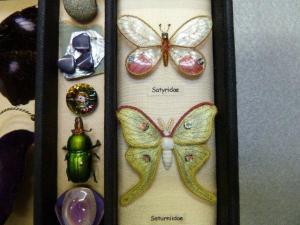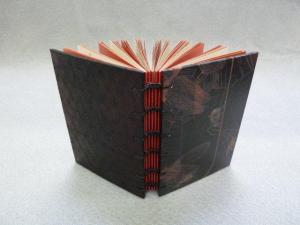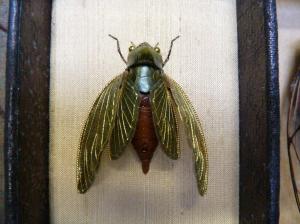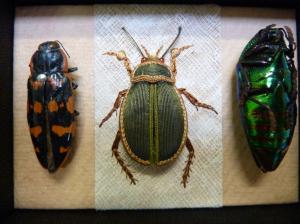The Red Chair – a needle in a haystack…



I’ve known Jane Nicholas for a number of years since I met her when I enrolled in a ‘how to’ class for stumpwork at our local embroidery shop, A Stitch In Time. In the course of conversation, she found out that I was a book and paper-artist and our friendship developed on a number of levels because we have similar backgrounds and we both deal in forms of communication and creative expression. I felt the ringing of those kindred spirit bells, – a sure sign there is a good friendship in the offing.

Over the years, I have left book and paper-art behind to become a fulltime writer, but Jane’s cheering from the front seat has always been a wonderful support for me. Her work of course, is the undeniable inspiration for The Stumpwork Robe and The Last Stitch (Books One and Two of The Chronicles of Eirie)
She is still my instructor when she visits Hobart for classes and we revert to student/teacher status for those hours. She is a superlative teacher, making detail that looks impossible to manage, easier to understand and achieve. As a world-recognised embroiderer, she has been awarded the Order of Australia and I felt a need to quiz her in the Big Red Chair.
Jane…
1. To begin with why don’t you tell us a little bit about yourself – where were you born? Raised? Schooled?
I was born in the small country town of Katanning in Western Australia. My parents moved to Perth when I was young. I went to Claremont Demonstration School (the local teacher’s college students practised their skills on us!) then to an all girls’ secondary school – which I loved.
2. What did you want to be when you were twelve, eighteen and thirty? And why?
When I was twelve I had no idea! At eighteen I was enamored with science – especially physics and maths – went to Sydney University and trained to be a secondary school teacher. I taught for a short while before I married and had children. At thirty I was married with three children and living on a sheep-grazing property. (the sheep-grazing thing is another coincidence between she and I) We bought the local fabric shop in Bowral, Chelsea Fabrics, and I thought that my working life would revolve around fabrics, furnishings and sewing machines. The shop was an institution in our town and I loved working there.
3. Then your life diverged. Why embroidery? And in particular why stumpwork?
We owned, and I worked in the shop for 34 years. I was invited to join an embroidery group which met every second Tuesday so I took Tuesdays off and joined – went along with my patchwork quilt that I was working on at the time (the closest form of embroidery that I had!). I decided to read books and learn about the various forms of embroidery by working examples – with the help of this group (we still meet!). I came across Muriel Baker’s book on stumpwork embroidery (remaindered at a local bookshop), and I was hooked!

4. But what was it about stumpwork in particular? What elements chimed within you that you just had to learn and to stitch?
I think it was the intimate nature of the work, the attention to fine detail and the element of “surprise” to reward close scrutiny. I am drawn to what I wrote in the introduction to my medieval flora book – I think it encapsulates what makes stumpwork so appealing: “- the intimate nature of the work, the considered placement of each stitch. Add to that the pleasure in taking time – to select exactly the right shade of silk, to research the botanical details of each plant, to add a “surprise” with the choice of an insect – faithfully interpreted with fabric, wire , beads and thread. Perhaps this helps to explain the continuing passion that many of us have for this form of embroidery.”
5. Stumpwork wasn’t a fashionable style of embroidery twenty years ago. It was cross-stitch, crewel and so on. How much time and research was involved before you began your first piece? What was that piece? Why that subject matter?
I started collecting every scrap of information I could find about stumpwork and decided that the best way to learn was to work a sampler based on typical 17th century English stumpwork embroideries featured in Muriel Baker’s book. I drew up my design – an amalgamation of many pieces – and started in the middle – thought that if I didn’t like it, I could just finish the central panel (I am not into unfinished works!). It took me five years – working out each technique as I went. The sampler was so much fun to work – I took it to the sewing group and just kept plugging away at it.
6. Is that the magnificent Royal Couple sampler with which most stumpworkers are familiar?
Yes.

7. Justifiably you have been honoured in Australia with an Order of Australia, as well as internationally for your skill and your contribution to furthering the art of embroidery. One would think that might have been your apogee but it seemed to spur you on. What keeps you reaching higher?
I just love the challenge of interpretation – the engineering of a flower or insect. Then the joy of sharing and teaching.
8. One of the exquisite features of your work is the innate detail and the similarity to nature. How often do you say ‘I want to embroider that but I really know I can’t’?
There are not many things that I won’t have a go at! Honeysuckle and columbines still have me thinking!
(I wished you’d said ‘Yes, heaps!’ Because I always wait with baited breath for what may challenge us in the next Masterclass and remember the horror of tackling chequerboard ‘snakeshead’ fritillaria!)
9. But why honeysuckle and columbine in particular? What makes them challenges?
Just the engineering of them! Honeysuckle has narrow tubular petals and columbine has fine detailed shapes – not sure how I would resolve that challenge. Perhaps one day ….
10. One of my favourite embroideries of yours is the Grand Eunuch taken from Ballet Russe’s Scheherezade. It is one of the few times I have seen you turn from nature to something else entirely. I can’t explain what it is about that exotic little figure, except that on seeing the actual costume was amazed at the reproductive skill you have shown. And the figure was so enthralling, he had to have his own spotlight in The Last Stitch. If you can, explain what prompted you to move away from nature in that instance and can you ever imagine a Scheherezade series?
There is a potential Diaghilev/Ballet Russes series in a box! I decided that that was what I was going to do when I finished my sampler. In 1993 I visited the National Art Gallery in Canberra and spent much time in the archives drawing the costumes in their collection. I designed twelve panels – the first one being The Chief Eunuch from Scheherezade. The second one is half done and the remainder are still drawings. The reason that I didn’t pursue this plan is because, by chance, I started teaching stumpwork embroidery in 1993 and it still continues.
(Then I must say as a stumpworker and also as a former book and paper-artist, I hope we get the chance to see that work eventuate into a book. Even if the stitching is beyond me, I would welcome the book into my library as a visual masterpiece.)
11. Change of tack now. Whom do you most admire and why?
Not sure that I can answer that one. I have great admiration for many strong women (including my mother and sister), who have persisted (despite adversity) and succeeded. Many women that I have encountered on my trips to India are perfect examples.
12. What is it about Indian women in particular that inspires your admiration?
Now you have me thinking! I was blown away by the quality and fineness of many of the embroideries that I saw, mostly produced under very difficult circumstances – limited time (because of all the household and external chores that had to be done as well), poor lighting, limited resources – and still they produced exquisite work . Also, an image etched on my memory – women working in a stone quarry, carrying huge loads of rock on their heads – wearing beautifully coloured saris and carrying themselves with such dignity. The Indian women I am referring to are obviously those still living under very traditional conditions. The disparity between them and the more privileged women is huge! Despite the conditions under which they must live, I am in awe of their ability to produce beautifully worked embroideries in the most adverse of conditions and with such grace. I was also touched by the interaction between the women and their gentle support of each other.
13. What are the last five websites you visited?
Probably something to do with butterflies and moths (as that is what I am working on at present) but I still prefer to turn to books for inspiration and information. I spend as little time on the computer as possible – at this stage it is only a tool for me.

14. What is the next challenge for you?
To finish the book on Moths and Butterflies that has been on the drawing board since 2006!

15. If you had your ‘druthers’ what would you do?
Anything to do with artists books and paper – my other love!
16. Can you explain in one sentence what it is about book and paper-art that stirs you?
That is really hard! Don’t really know what it is but there is something compelling about making a beautifully crafted book or box (I cannot do free or casual!) and the potential that it offers for “containment” – words, images, memories, ideas. I am an avid collector of “stuff” and love the sorting and ordering of same .

Part of a box of ephemera that Jane created as a ‘book and paper artist’ for a Fantasy Exhibition at the Goulburn Regional Art Gallery.
17. If music be the food of love, what do you think embroidery is and please explain your answer?
A mix of extreme challenge, great joy and meditation!
Lovely comment. One can’t but agree with the sentiments. Jane, thank you so much for making the time to talk in what is always a hectic schedule for you. Best wishes from me and from your fellow stitchers.
More detail about Jane and her work can be found at her website where it is possible to buy her books and all stumpwork embroidery supplies and kits.

I am blown away by stumpwork embroidery. Looking at it I am overcome by admiration and amazement at the detail and beauty! It’s one of those things that I wish I could try but feel I wouldn’t have the patience. Also I was interested to read the reference to Katanning, because my mum did a stint as a kindergarten teacher there. 🙂
I’m still in awe of what can be achieved with stumpwork. There are many things that are beyond me, but if, as with the mirror last year, I stick with the things I can handle, I love every minute of the stitching.
Jane’s work close up however, is beyond belief.
She must have brilliant eyesight and incredibly steady hands! And I have to say Prue, from what I have seen of your work, it’s up there as well. I love my little stumpwork owl that I won at the Masquerade Ball!
After working on the graphics based on the Stumpwork Robe, I agree that Jane Nicholas is a wonder of the world. I’ve never done any needlework myself, but working in miniature with paper must be similar in a lot of ways. Prue, I’m so glad you’ve worked in both media – it informs your writing so much!
Pat, I think if it has done anything (apart from inspire me), it has increased my powers of observation. For me as a writer, if I couldn’t observe the minutiae of life from moods to mushrooms, I think my writing would be the poorer.